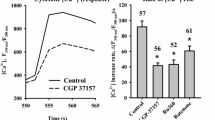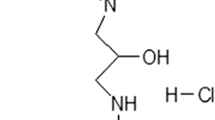Abstract
The effect of hydrogen peroxide (H2O2) on cytosolic free calcium concentration ([Ca2+]c) as well as its effect on glutamate secretion in rat hippocampal astrocytes have been the aim of the present research. Our results show that 100 μM H2O2 induces an increase in [Ca2+]c, that remains at an elevated level while the oxidant is present in the perfusion medium, due to its release from intracellular stores as it was observed in the absence of extracellular Ca2+, followed by a significant increase in glutamate secretion. Ca2+-mobilization in response to the oxidant could only be reduced by thapsigargin plus FCCP, indicating that the Ca2+-mobilizable pool by H2O2 includes both endoplasmic reticulum and mitochondria. We conclude that ROS in hippocampal astrocytes might contribute to an elevation of resting [Ca2+]c which, in turn, could lead to a maintained secretion of the excitatory neurotransmitter glutamate, which has been considered a situation potentially leading to neurotoxicity in the hippocampus.






Similar content being viewed by others
References
Araque A, Carmignoto G, Haydon PG (2001) Dynamic signalling between astrocytes and neurons. Annu Rev Physiol 63:795–813
Haydon PG (2001) GLIA: listening and talking to the synapse. Nat Rev Neurosci 2:185–193
Koizumi S, Fujishita K, Tsuda M et al. (2003) Dynamic inhibition of excitatory synaptic transmission by astrocytes-derived ATP in hippocampal cultures. P Natl Acad Sci USA 100:11023–11028
Braet K, Cabooter L, Paemeleire K et al. (2004) Calcium signal communication in the central nervous system. Biol Cell 96:79–91
Verkhratsky A, Orkand RK, Kettenmann H (1998) Glial calcium: homeostasis and signalling function. Physiol Rev 78:99–141
Duchen MR (2000) Mitochondria and Ca2+ in cell physiology and pathophysiology. Cell Calcium 28:339–348
Jung S, Pfeiffer F, Deitmer JW (2000) Histamine-induced calcium entry in rat cerebellar astrocytes: evidence for capacitative and non-capacitative mechanisms. J Physiol London 527:549–561
Turrens JF (2003) Mitochondrial formation of reactive oxygen species. J Physiol London 522:335–344
Rosado JA, Redondo PC, Salido GM et al. (2006) Calcium signaling and reactive oxygen species in non-excitable cells. Mini-Revs Med Chem 6:409–415
Verkhratsky A, Kettenmann H (1996) Calcium signalling in glial cells. Trends Neurosci 19:346–352
Emerit J, Edeas M, Bricaire F (2004) Neurodegenerative diseases and oxidative stress. Biomed Pharmacother 58:39–46
Metodiewa D, Koska C (2002) Reactive oxygen species and reactive nitrogen species: relevance to cyto(neuro)toxic events and neurologic disorders. An overview. Neurotox Res 1:197–233
Grynkiewicz G, Poenie M, Tsien RY (1985) A new generation of Ca2+ indicators with greatly improved fluorescence properties. J Biol Chem 260:3440–3450
Dallwig R, Deitmer JW (2002) Cell-type specific calcium responses in acute rat hippocampal slices. J Neurosci Meth 116:77–87
Beck A, Nieden RZ, Schneider HP et al. (2004) Calcium release from intracellular stores in rodent astrocytes and neurons in situ. Cell Calcium 35:47–58
Rodríguez-Moreno A, Sihra TS (2004) Presynaptic kainate receptor facilitation of glutamate release involves protein kinase A in the rat hippocampus. J Physiol London 557:733–745
Decker T, Lohmann-Matthes ML (1998) A quick and simple method for the quantitation of lactate dehydrogenase release in measurements of cellular cytotoxicity and tumor necrosis factor (TNF) activity. J Immunol Methods 15:61–69
Vestergaard HT, Vogensen SB, Madsen U et al. (2004) Analogues of homoibotenic acid show potent and selective activity following sensitization by quisqualic acid. Eur J Pharmacol 488:101–109
Ireland DR, Guevremont D, Williams JM et al. (2004) Metabotropic glutamate receptor-mediated depression of the slow after hyperpolarization is gated by tyrosine phosphatases in hippocampal CA1 pyramidal neurons. J Neurophysiol 92:2811–2819
Humez S, Legrand G, Vanden-Abeele F et al. (2004). Role of endoplasmic reticulum calcium content in prostate cancer cell growth regulation by IGF and TNFalpha. J Cell Physiol 201:201–213
González A, Schulz I, Schmid A (2000) Agonist-evoked mitochondrial Ca2+ signals in mouse pancreatic acinar cells. J Biol Chem 275:38680–38686
Mattson MP, Chan SL (2003) Neuronal and glial calcium signalling in Alzheimer’s disease. Cell Calcium 34:385–397
Xu J, Yu S, Sun AY et al. (2003) Oxidant-mediated AA release from astrocytes involves cPLA(2) and iPLA(2). Free Radical Bio Med 34:1531–1543
Jacobson J, Duchen MR (2002) Mitochondrial oxidative stress and cell death in astrocytes-requirement for stored Ca2+ and sustained opening of the permeability transition pore. J Cell Sci 115:1175–1188
Sánchez S, Fernández-Belda F, Soler F (2004) Functional effect of hydrogen peroxide on the sarcoplasmic reticulum membrane: uncoupling and irreversible inhibition of the Ca2+-ATPase protein. Arch Biochem Biophys 431:245–251
Henschke PN, Elliott SJ (1995) Oxidized glutathione decreases luminal Ca2+ content of the endothelial cell Ins(1,4,5)P3-sensitive Ca2+ store. Biochem J 312:485–489
Pereira C, Ferreira C, Carvalho C et al. (1996) Contribution of plasma membrane and endoplasmic reticulum Ca2+-ATPases to the synaptosomal [Ca2+]i increase during oxidative stress. Brain Res 713:269–277
Viner RI, Krainev AG, Williams TD et al. (1997) Identification of oxidation-sensitive peptides within the cytoplasmic domain of the sarcoplasmic reticulum Ca2+-ATPase. Biochemistry 36:7706–7716
Barnes KA, Samson SE, Grover AK (2000) Sarco/endoplasmic reticulum Ca2+-pump isoform SERCA3a is more resistant to superoxide damage than SERCA2b. Mol Cell Biochem 203:17–21
Zaidi A, Michaelis M (1999) Effects of reactive oxygen species on brain synaptic plasma membrane Ca2+-ATPase. Free Radical Bio Med 27:810–821
Pariente JA, Camello C, Camello PJ et al. (2001) Release of calcium from mitochondrial and nonmitochondrial intracellular stores in mouse pancreatic acinar cells by hydrogen peroxide. J Membr Biol 179:27–35
Kourie JI (1998) Interaction of reactive oxygen species with ion transport mechanisms. Am J Physiol Cell Ph 275:1–24
Innocenti B, Parpura V, Haydon PG (2000) Imaging extracellular waves of glutamate during calcium signalling in cultured astrocytes. J Neurosci 20:1800–1808
Parpura V, Haydon PG (2000) Physiological astrocytic calcium levels stimulate glutamate release to modulate adjacent neurons. P Natl Acad Sci USA 97:8629–8634
Cavelier P, Attwell D (2005) Tonic release of glutamate by a DIDS-sensitive mechanism in rat hippocampal slices. J Physiol London 564:397–410
Ouyang YB, Carriedo SG, Giffard RG (2002) Effect of Bcl-XL overexpression on reactive oxygen species, intracellular calcium, and mitochondrial membrane potential following injury of astrocytes. Free Radical Bio Med 33:544–551
Acknowledgements
This work was supported by Junta de Extremadura-Consejería de Educación, Ciencia y Tecnología (2PR04A009). María P. Granados is supported by a grant from Consejería de Educación, Ciencia y Tecnología-Junta de Extremadura y Fondo Social Europeo (FIC02A022). The authors would like to thank Dr. Rafael Fernández Chacón and Mr. Pablo García-Junco Clemente from the Faculty of Medicine of the University of Sevilla for their valuable criticisms and help in preparing the cell cultures, and Mrs. Mercedes Gómez Blázquez, from the Department of Physiology of the University of Extremadura, for her technical assistance.
Author information
Authors and Affiliations
Corresponding author
Rights and permissions
About this article
Cite this article
González, A., Granados, M.P., Pariente, J.A. et al. H2O2 Mobilizes Ca2+ from Agonist- and Thapsigargin-sensitive and Insensitive Intracellular Stores and Stimulates Glutamate Secretion in Rat Hippocampal Astrocytes. Neurochem Res 31, 741–750 (2006). https://doi.org/10.1007/s11064-006-9078-y
Accepted:
Published:
Issue Date:
DOI: https://doi.org/10.1007/s11064-006-9078-y




